What Is Dry Eye?
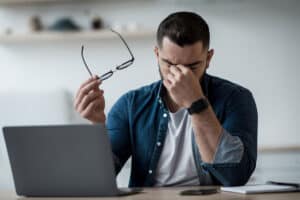 The eyes need tears to remain healthy, functional, and comfortable. If you notice that your eyes are not producing enough tears, you may have dry eye. Dry eye is a common eye condition that affects the tear film that covers the cornea. This film is composed of three distinct layers that work in unison to keep your eyes nourished. Any disturbance to the tear film can result in bothersome symptoms, such as:
The eyes need tears to remain healthy, functional, and comfortable. If you notice that your eyes are not producing enough tears, you may have dry eye. Dry eye is a common eye condition that affects the tear film that covers the cornea. This film is composed of three distinct layers that work in unison to keep your eyes nourished. Any disturbance to the tear film can result in bothersome symptoms, such as:
- A burning or stinging sensation in the eyes
- Sensitivity to light
- Blurry vision
- Unexplained changes in vision
- Eye discharge
Although it may seem counterintuitive, watery eyes may also be a symptom of dry eyes. This can happen when the meibomian glands do not produce enough oil to coat the outermost layer of the tear film, causing the underlying watery layer of tear film to evaporate too quickly. In response to this imbalance, the lacrimal glands produce more tears — although they are not able to properly coat the eyes — leaving many dry eye sufferers with watery eyes.
Dry eye can occur alone or appear alongside other medical conditions, such as diabetes, certain eye diseases, or blepharitis.
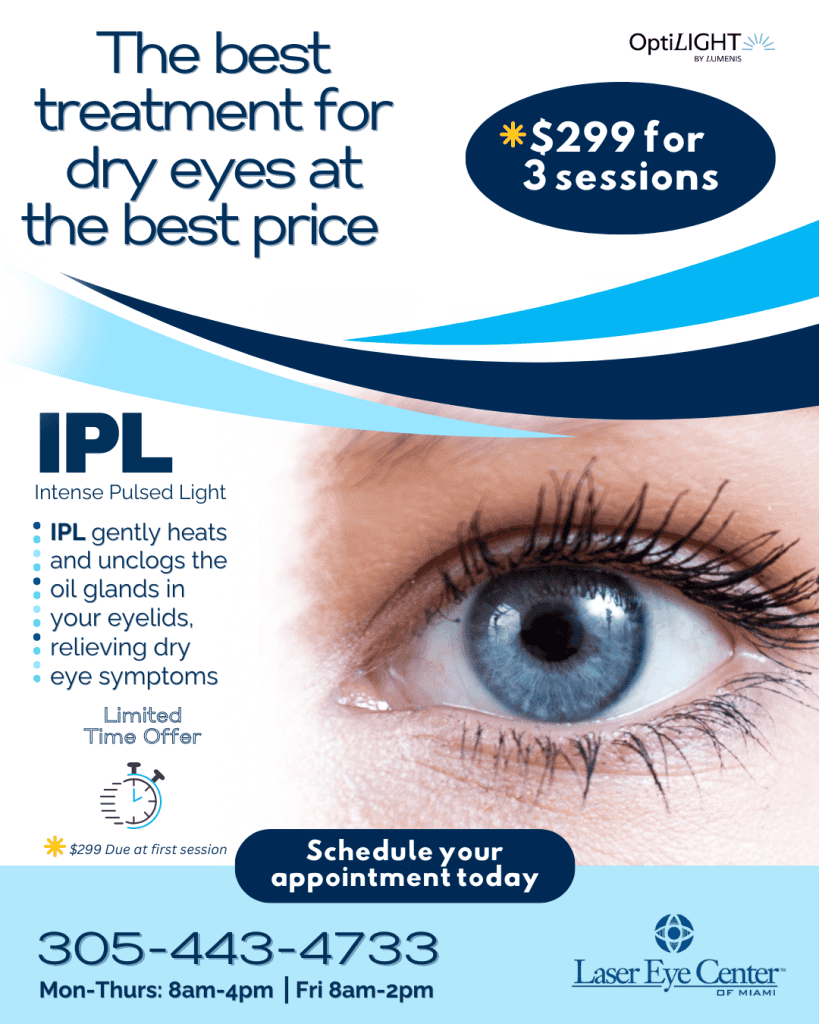
Dry Eye Risk Factors
There are many factors that can increase your risk for dry eye, including:
Age: As you get older, your likelihood of dry eye increases.
Lifestyle: Factors such as your environment, the amount of time you spend looking at screens, and allergies can influence the health of your eyes and trigger dry eye symptoms.
Certain medications: Certain medications, such as those that treat allergies, systemic retinoids, and hypertension, can increase the risk of dry eye.
Diagnosing Dry Eye
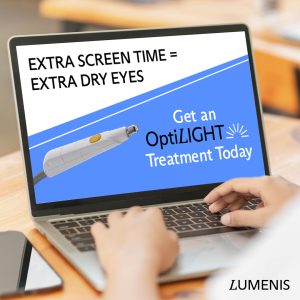 Tests will also be performed to help diagnose dry eye. These include:
Tests will also be performed to help diagnose dry eye. These include:
Slit lamp exam: The slit lamp exam helps our doctors get a gauge of the amount of tears your eyes are producing. It involves shining a light into each of the eyes and then using a microscope to thoroughly examine the eyes and eyelids.
Schirmer’s test: Tear production may also be measured with Schirmer’s test. A small strip of paper is placed at the edge of the eyelid and left there for several minutes. The eyes will naturally produce tears in response, which are then measured by examining the amount of paper that is covered.
Tear breakup time test: This test is performed to evaluate how fast the tears evaporate. This requires our doctors to place dye into the eyes to determine the stability of the tear film.
Treatment Options
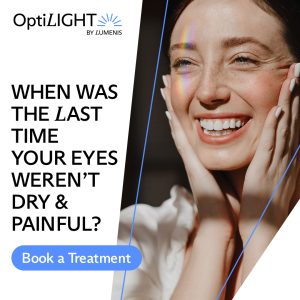 The goal of dry eye treatment is to alleviate symptoms and limit potential damage to the delicate surface of the eyes. Your treatment options may include:
The goal of dry eye treatment is to alleviate symptoms and limit potential damage to the delicate surface of the eyes. Your treatment options may include:
Artificial tears: Artificial tears relieve mild symptoms of dry eye and provide an instant boost of moisture. They are specifically formulated to replicate natural tears, which may help your eyes stay comfortable and lubricated.
Ointments: Some patients require a thicker formula to eliminate eye irritation and dryness. Ointments are a great option in these cases and are also ideal for bedtime use.
IPL therapy: Short for intense pulsed light, IPL is an advanced technology that uses light pulses that target the meibomian glands, effectively eliminating any substances that could be contributing to gland blockage. This treatment can help restore the function of the meibomian glands, which are essential to a healthy tear film.
FAQs
How Can You Tell the Difference Between Dry Eye and Allergies?
Dry eye and eye allergies share symptoms like redness, irritation, and burning, making it hard to tell them apart. However, allergies often come with itchiness, watery eyes, and nasal congestion, while dry eye causes a gritty or foreign body sensation. If your symptoms worsen in dry environments or after prolonged screen time, you may be dealing with dry eye rather than allergies.
Can Dry Eye Be a Temporary Condition, or Is It Always Chronic?
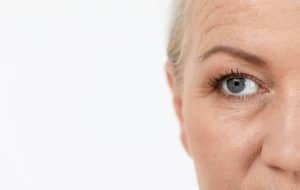 Dry eye can be temporary or chronic, depending on the cause. Environmental factors like wind, air conditioning, and prolonged screen use can trigger short-term dryness. However, if you experience ongoing symptoms due to aging, hormonal changes, or underlying health conditions, your dry eye may be chronic and require long-term management.
Dry eye can be temporary or chronic, depending on the cause. Environmental factors like wind, air conditioning, and prolonged screen use can trigger short-term dryness. However, if you experience ongoing symptoms due to aging, hormonal changes, or underlying health conditions, your dry eye may be chronic and require long-term management.
How Do You Know If Your Dry Eye Symptoms Require Medical Treatment?
Mild dry eye can often be managed with artificial tears and lifestyle changes. However, if your symptoms persist, worsen, or interfere with daily activities, medical treatment may be necessary. Signs that you should seek professional care include constant discomfort, excessive tearing, light sensitivity, or blurry vision that doesn’t improve with blinking.
Are There Any Lifestyle Changes That Can Help Prevent Dry Eye?
Yes, small adjustments to your daily routine can reduce dry eye symptoms. Blinking more often, taking breaks from screens, using a humidifier, and staying hydrated all support eye moisture. Additionally, wearing sunglasses outdoors and avoiding direct airflow from fans or air conditioning can help prevent excessive eye dryness.
Is IPL Therapy for Dry Eye Painful or Uncomfortable?
Intense Pulsed Light (IPL) therapy is a safe, non-invasive treatment for dry eye. Most people tolerate the procedure well, experiencing only mild warmth or a slight snapping sensation. The treatment is quick, and any discomfort is minimal. Your eye specialist may also apply cooling gel to enhance comfort during the procedure.
How Long Does It Take to See Results from IPL Therapy for Dry Eye?
Many patients notice some improvement after their first IPL session, but optimal results typically require multiple treatments. Over the course of several weeks, IPL helps unclog oil glands, reducing inflammation and improving tear quality. Your doctor will recommend a treatment plan based on your specific needs.
Can You Wear Contact Lenses If You Have Dry Eye?
Yes, but it depends on the severity of your condition. Standard contact lenses can worsen dryness, but switching to daily disposable or specialty lenses designed for dry eye can improve comfort. Using lubricating drops and following your eye doctor’s recommendations can also help you continue wearing contacts without irritation.
Are Artificial Tears Enough to Combat Dry Eye?
Artificial tears can provide temporary relief, but they may not address the underlying cause of your dry eye. If your symptoms persist despite frequent use, you may need additional treatments like prescription eye drops, IPL therapy, or lifestyle modifications. Your eye specialist can determine the best approach for long-term relief.
If dry eye is affecting your daily life, don’t wait for symptoms to worsen. The experts at Laser Eye Center of Miami offer advanced treatments tailored to your needs. Schedule a consultation today to find the right solution and enjoy lasting relief from dry, irritated eyes.
Choose Laser Eye Center of Miami
For more information on dry eye treatment, contact our office to schedule your eye appointment today.







